Pentaethylenehexamine-Loaded Hierarchically Porous Silica for CO2 Adsorption
Abstract
:1. Introduction
2. Experimental
2.1. Material Preparation
2.1.1. Preparation of the Support
2.1.2. Preparation of the Adsorbent
2.2. Measurements of CO2 Adsorption Capacity
2.3. Characterization
3. Results and Discussion
3.1. Characterization of Adsorbents
3.2. Effect of PEHA Loading on CO2 Adsorption
3.3. Effect of Adsorption Temperature on CO2 Adsorption
3.4. Regenerability of HPS-PEHA-70
3.5. Breakthrough Analysis Based on the Deactivation Model
4. Conclusions
Acknowledgments
Author Contributions
Conflicts of Interest
References
- Freis, J.; Vohlidka, P.; Günthner, W.A. Low-Carbon Warehousing: Examining Impacts of Building and Intra-Logistics Design Options on Energy Demand and the CO2 Emissions of Logistics Centers. Sustainability 2016, 8, 448. [Google Scholar] [CrossRef]
- Essenhigh, R.H. Potential Dependence of Global Warming on the Residence Time (RT) in the Atmosphere of Anthropogenically Sourced Carbon Dioxide. Energy Fuels 2009, 23, 2773–2784. [Google Scholar] [CrossRef]
- Judkins, R.R.; Fulkerson, W. The Dilemma of Fossil Fuel Use and Global Climate Change. Energy Fuels 1993, 7, 14–22. [Google Scholar] [CrossRef]
- Bermúdez, J.M.; Dominguez, P.H.; Arenillas, A.; Luque, R. CO2 Separation and Capture Properties of Porous Carbonaceous Materials from Leather Residues. Materials 2013, 6, 4641–4653. [Google Scholar] [CrossRef]
- Xu, X.C.; Song, C.S.; Miller, B.G.; Scaroni, A.W. Influence of Moisture on CO2 Separation from Gas Mixture by a Nanoporous Adsorbent Based on Polyethylenimine-Modified Molecular Sieve MCM-41. Ind. Eng. Chem. Res. 2005, 44, 8113–8119. [Google Scholar] [CrossRef]
- Sun, N.N.; Sun, C.G.; Snape, C.E.; Wei, W.; Sun, Y.H. Surface-modified spherical activated carbon materials for pre-combustion carbon dioxide capture. RSC Adv. 2015, 5, 33681–33690. [Google Scholar] [CrossRef]
- Im, J.H.; Ko, N.; Kim, J.; Park, C.R. Enhanced water stability and CO2 gas sorption properties of a methyl functionalized titanium metal–organic framework. New J. Chem. 2014, 38, 2752–2755. [Google Scholar] [CrossRef]
- Daud, F.D.M.; Vignesh, K.; Sreekantan, S. Improved CO2 adsorption capacity and cyclic stability of CaO sorbents incorporated with MgO. New J. Chem. 2016, 40, 231–237. [Google Scholar] [CrossRef]
- Sevilla, M.; Falco, C.; Titirici, M.-M.; Fuertes, A.B. High-performance CO2 sorbents from algae. RSC Adv. 2012, 2, 12792–12797. [Google Scholar] [CrossRef]
- Thiruvenkatachari, R.; Su, S.; An, H. Post combustion CO2 capture by carbon fibre monolithic adsorbents. Prog. Energy Combust. Sci. 2009, 35, 438–455. [Google Scholar] [CrossRef]
- Zhou, L.Y.; Fan, J.; Shang, X.M. CO2 Capture and Separation Properties in the Ionic Liquid 1-n-Butyl-3-Methylimidazolium Nonafluorobutylsulfonate. Materials 2014, 7, 3867–3880. [Google Scholar] [CrossRef]
- Wang, M.; Lawal, A.; Stephenson, P.; Sidders, J.; Ramshaw, C. Post-combustion CO2 capture with chemical absorption: A state-of-the-art review. Chem. Eng. Res. Des. 2001, 89, 1609–1624. [Google Scholar] [CrossRef] [Green Version]
- Hedin, N.; Chen, L.J.; Laaksonen, A. Sorbents for CO2 capture from flue gas—Aspects from materials and theoretical chemistry. Nanoscale 2010, 2, 1819–1841. [Google Scholar] [CrossRef] [PubMed]
- Wang, J.; Huang, L.; Yang, R.; Zhang, Z.; Wang, Q.; Zhong, Z.Y. Recent advances in solid sorbents for CO2 capture and new development trends. Energy Environ. Sci. 2014, 7, 3478–3518. [Google Scholar] [CrossRef]
- Shakarova, D.; Ojuva, A.; Bergström, L.; Akhtar, F. Methylcellulose-Directed Synthesis of Nanocrystalline Zeolite NaA with High CO2 Uptake. Materials 2014, 7, 5507–5519. [Google Scholar] [CrossRef]
- Fan, L.S.; Zeng, L.; Wang, W.; Luo, S. Chemical looping processes for CO2 capture and carbonaceous fuel conversion–prospect and opportunity. Energy Environ. Sci. 2012, 5, 7254–7280. [Google Scholar] [CrossRef]
- Liao, Y.S.; Hu, Z.N.; Gu, Q.; Xue, C. Amine-Functionalized ZnO Nanosheets for Efficient CO2 Capture and Photoreduction. Molecules 2015, 20, 18847–18855. [Google Scholar] [CrossRef] [PubMed]
- Liu, W.; King, D.; Liu, J.; Johnson, B.; Wang, Y.; Yang, Z.G. Critical Material and Process Issues for CO2 Separation from Coal-Powered Plants. JOM 2009, 61, 36–44. [Google Scholar] [CrossRef]
- Gadipelli, S.; Travis, W.; Guo, Z.X. A thermally derived and optimized structure from ZIF-8 with giant enhancement in CO2 uptake. Energy Environ. Sci. 2014, 7, 2232–2238. [Google Scholar] [CrossRef]
- Qi, C.X.; Su, H.J.; Guan, R.G.; Xu, X.Y. An Investigation into Phosphate-Doped Au/Alumina for Low Temperature CO Oxidation. J. Phys. Chem. C 2012, 116, 17492–17500. [Google Scholar] [CrossRef]
- Fabiano, T.A.; Soares, V.P.; Andreoli, E. Pentaethylenehexamine-C60 for Temperature Consistent Carbon Capture. Carbon 2015, 1, 16–26. [Google Scholar] [CrossRef]
- Querejeta, N.; Plaza, M.G.; Rubiera, F.; Pevida, C. Water Vapor Adsorption on Biomass Based Carbons under Post-Combustion CO2 Capture Conditions: Effect of Post-Treatment. Materials 2016, 9, 359. [Google Scholar] [CrossRef]
- Li, J.J.; Michael Hitch, M. Carbon Dioxide Sorption Isotherm Study on Pristine and Acid-Treated Olivine and Its Application in the Vacuum Swing Adsorption Process. Minerals 2015, 5, 259–275. [Google Scholar] [CrossRef]
- Dao, D.S.; Yamada, H.; Yogo, K. Large-Pore Mesostructured Silica Impregnated with Blended Amines for CO2 Capture. Ind. Eng. Chem. Res. 2013, 52, 13810–13817. [Google Scholar] [CrossRef]
- Sathre, R.; Masanet, E. Prospective life-cycle modeling of a carbon capture and storage system using metal-organic frameworks for CO2 capture. RSC Adv. 2013, 3, 4964–4975. [Google Scholar] [CrossRef]
- Zelenak, V.; Halamova, D.; Gaberova, L.; Bloch, E.; Llewellyn, P. Amine-modified SBA-12 mesoporous silica for carbon dioxide capture: Effect of amine basicity on sorption properties. Microporous Mesoporous Mater. 2008, 116, 358–364. [Google Scholar] [CrossRef]
- Zhang, J.; Xing, Z.C.; Wang, J.G. Analysis of CO2 Emission Performance and Abatement Potential for Municipal Industrial Sectors in Jiangsu, China. Sustainability 2016, 8, 697. [Google Scholar] [CrossRef]
- Yue, M.B.; Sun, L.B.; Cao, Y.; Wang, Y.; Wang, Z.J.; Zhu, J.H. Efficient CO2 Capturer Derived from As-Synthesized MCM-41 Modified with Amine. Chem. Eur. J. 2008, 14, 3442–3451. [Google Scholar] [CrossRef] [PubMed]
- Sircar, S.; Golden, T.C. Isothermal and Isobaric Desorption of Carbon Dioxide by Purge. Ind. Eng. Chem. Res. 1995, 34, 2881–2888. [Google Scholar] [CrossRef]
- Franchi, R.S.; Harlick, P.J.E.; Sayari, A. Applications of Pore-Expanded Mesoporous Silica. 2. Development of a High-Capacity, Water-Tolerant Adsorbent for CO2. Ind. Eng. Chem. Res. 2005, 44, 8007–8013. [Google Scholar] [CrossRef]
- Hsu, S.C.; Lu, C.; Su, F.; Zeng, W.W. Thermodynamics and regeneration studies of CO2 adsorption on multiwalled carbon nanotubes. Chen. Chem. Eng. Sci. 2010, 65, 1354–1361. [Google Scholar] [CrossRef]
- Coriani, S.; Halkier, A.; Rizzo, A.; Ruud, K. On the molecular electric quadrupole moment and the electric-field-gradient-induced birefringence of CO2 and CS2. Chem. Phys. Lett. 2000, 326, 269–276. [Google Scholar] [CrossRef]
- Duanne, J.A.; Rao, M.; Sircar, S.; Gorte, R.J.; Myers, A.L. Calorimetric Heats of Adsorption and Adsorption Isotherms. 2. O2, N2, Ar, CO2, CH4, C2H6, and SF6 on NaX, H-ZSM-5, and Na-ZSM-5 Zeolites. Langmuir 1996, 12, 5896–5904. [Google Scholar] [CrossRef]
- Hiyoshi, N.; Yogo, K.; Yashima, T. Adsorption of Carbon Dioxide on Amine Modified SBA-15 in the Presence of Water Vapor. Chem. Lett. 2004, 33, 510–511. [Google Scholar] [CrossRef]
- Vilarrasa-García, E.; Cecilia, J.A.; Moya, E.M.O.; Rodríguez-Castellón, E. “Low Cost” Pore Expanded SBA-15 Functionalized with Amine Groups Applied to CO2 Adsorption. Materials 2015, 8, 2495–2513. [Google Scholar] [CrossRef]
- Zhao, A.; Samanta, A.; Sarkar, P.; Gupta, R. Carbon Dioxide Adsorption on Amine-Impregnated Mesoporous SBA-15 Sorbents: Experimental and Kinetics Study. Ind. Eng. Chem. Res. 2013, 52, 6480–6491. [Google Scholar] [CrossRef]
- Xu, X.C.; Song, C.S.; Andresen, J.M.; Miller, B.G.; Scaroni, A.W. Novel Polyethylenimine-Modified Mesoporous Molecular Sieve of MCM-41 Type as High-Capacity Adsorbent for CO2 Capture. Energy Fuels 2002, 16, 1463–1469. [Google Scholar] [CrossRef]
- Maroto Valer, M.M.; Lu, Z.; Zhang, Y.; Tang, Z. Sorbents for CO2 capture from high carbon fly ashes. Waste Manag. 2008, 28, 2320–2328. [Google Scholar] [CrossRef] [PubMed]
- Gargiulo, N.; Caputo, D.; Colella, C. Preparation and characterization of polyethylenimine-modified mesoporous silicas as CO2 sorbents. In Proceedings of the 15th International Zeolite Conference, Beijing, China, 12–17 August 2007; pp. 1938–1943.
- Yan, X.L.; Zhang, L.; Zhang, Y.; Yang, G.D.; Yan, Z. Amine-Modified SBA-15: Effect of Pore Structure on the Performance for CO2 Capture. Ind. Eng. Chem. Res. 2011, 50, 3220–3226. [Google Scholar] [CrossRef]
- Serna Guerrero, R.; Belmabkhout, Y.; Sayari, A. Further investigations of CO2 capture using triamine-grafted pore-expanded mesoporous silica. Chem. Eng. J. 2010, 158, 513–519. [Google Scholar] [CrossRef]
- Ma, X.L.; Wang, X.; Song, C.S. “Molecular Basket” Sorbents for Separation of CO2 and H2S from Various Gas Streams. J. Am. Chem. Soc. 2009, 131, 5777–5783. [Google Scholar] [CrossRef] [PubMed]
- Qi, G.; Wang, Y.; Estevez, L.; Duan, X.; Anako, N.; Park, A.H.A.; Li, W.; Jones, C.W.; Giannelis, E.P. High efficiency nanocomposite sorbents for CO2 capture based on amine-functionalized mesoporous capsules. Energy Environ. Sci. 2011, 4, 444–452. [Google Scholar] [CrossRef]
- Wei, L.; Gao, Z.M.; Jing, Y.; Wang, Y.D. Adsorption of CO2 from Simulated Flue Gas on Pentaethylenehexamine-Loaded Mesoporous Silica Support Adsorbent. Ind. Eng. Chem. Res. 2013, 52, 14965–14974. [Google Scholar] [CrossRef]
- Samanta, A.; Zhao, A.; George, K.; Shimazu, H.; Sarkar, P.; Gupta, R. Post-Combustion CO2 Capture Using Solid Sorbents: A Review. Ind. Eng. Chem. Res. 2012, 51, 1438–1463. [Google Scholar] [CrossRef]
- Pirouz, S.; Wang, Y.L.; Chong, J.M.; Duhamel, J. Chemical Modification of Polyisobutylene Succinimide Dispersants and Characterization of Their Associative Properties. J. Phys. Chem. B 2015, 119, 12202–12211. [Google Scholar] [CrossRef] [PubMed]
- Yates, M.Z.; O’Neill, M.L.; Johnston, K.P. Emulsion Stabilization and Flocculation in CO2. 2. Dynamic Light Scattering. Macromolecules 1997, 30, 5060–5067. [Google Scholar] [CrossRef]
- Smått, J.H.; Schunk, S.; Linde´n, M. Versatile Double-Templating Synthesis Route to Silica Monoliths Exhibiting a Multimodal Hierarchical Porosity. Chem. Mater. 2003, 15, 2354–2361. [Google Scholar] [CrossRef]
- Anunziata, O.A.; Martínez, M.L.; Beltramone, A.R. Hydroxyapatite/MCM-41 and SBA-15 Nano-Composites: Preparation, Characterization and Applications. Materials 2009, 2, 1508–1519. [Google Scholar] [CrossRef]
- Brad, H.J.; Timothy, P.L. Hierarchically Porous Silica Prepared from Ionic Liquid and Polymeric Bicontinuous Microemulsion Templates. Chem. Mater. 2011, 23, 4824–4831. [Google Scholar]
- Zhou, Y.; Schattka, J.H.; Antonietti, M. Room-Temperature Ionic Liquids as Template to Monolithic Mesoporous Silica with Wormlike Pores via a Sol−Gel Nanocasting Technique. Nano Lett. 2004, 4, 477–481. [Google Scholar] [CrossRef]
- Barrett, E.P.; Joyner, L.G.; Halenda, P.P. The Determination of Pore Volume and Area Distributions in Porous Substances. I. Computations from Nitrogen Isotherms. J. Am. Chem. Soc. 1951, 73, 373–380. [Google Scholar] [CrossRef]
- Gunathilake, C.; Jaroniec, M. Mesoporous Organosilica with Amidoxime Groups for CO2 Sorption. Appl. Mater. Interfaces 2014, 6, 13069–13078. [Google Scholar] [CrossRef] [PubMed]
- Kim, S.; Ida, J.; Guliants, V.V.; Lin, J.Y.S. Tailoring Pore Properties of MCM-48 Silica for Selective Adsorption of CO2. J. Phys. Chem. B 2005, 109, 6287–6293. [Google Scholar] [CrossRef] [PubMed]
- Gargiulo, N.; Peluso, A.; Aprea, P.; Pepe, F.; Caputo, D. CO2 Adsorption on Polyethylenimine-Functionalized SBA-15 Mesoporous Silica: Isotherms and Modeling. J. Chem. Eng. Data 2014, 59, 896–902. [Google Scholar] [CrossRef]
- Jaroniec, C.P.; Kruk, M.; Jaroniec, M.; Sayari, A. Tailoring surface and structural properties of MCM-41 silicas by bonding organosilanes. Phys. Chem. B 1998, 102, 5503–5510. [Google Scholar] [CrossRef]
- Wang, X.X.; Schwartz, V.; Song, C.S. Infrared Study of CO2 Sorption over “Molecular Basket” Sorbent Consisting of Polyethylenimine-Modified Mesoporous Molecular Sieve. Phys. Chem. C 2009, 113, 7260–7268. [Google Scholar] [CrossRef]
- Socrates, G. Infrared and Raman Characteristic Group Frequencies; John Wiley & Sons: Chichester, UK, 2001. [Google Scholar]
- Yoshitake, H.; Koiso, E.; Horie, H.; Yoshimura, H. Polyamine-functionalized mesoporous silicas: Preparation, structural analysis and oxyanion adsorption. Microporous Mesoporous Mater. 2005, 85, 183–194. [Google Scholar] [CrossRef]
- Hiyoshi, N.; Yogo, K.; Yashima, T. Adsorption characteristics of carbon dioxide on organically functionalized SBA-15. Microporous Mesoporous Mater. 2005, 84, 357–365. [Google Scholar] [CrossRef]
- Wang, L.; Yang, R.T. Increasing Selective CO2 Adsorption on Amine-Grafted SBA-15 by Increasing Silanol Density. J. Phys. Chem. C 2011, 115, 21264–21272. [Google Scholar] [CrossRef]
- Khatri, R.A.; Chuang, S.S.C.; Song, Y.; Gray, M. Carbon Dioxide Capture by Diamine-Grafted SBA-15: A Combined Fourier Transform Infrared and Mass Spectrometry Study. Ind. Eng. Chem. Res. 2005, 44, 3702–3708. [Google Scholar] [CrossRef]
- Li, Y.; Sun, N.N.; Li, L.; Zhao, N.; Wei, W.; Sun, Y.H. Grafting of Amines on Ethanol-Extracted SBA-15 for CO2 Adsorption. Materials 2013, 6, 981–999. [Google Scholar] [CrossRef]
- Wei, L.; Lan, R.; Jing, Y. Modification of MCM-41 with pentaethylenehexamine (PEHA) and its performance of adsorption for CO2. Chem. Ind. Eng. Prog. 2011, 30, 143–148. [Google Scholar]
- Klinthong, W.; Huang, C.-H.; Tan, C.-S. One-Pot Synthesis and Pelletizing of Polyethylenimine-Containing Mesoporous Silica Powders for CO2 Capture. Ind. Eng. Chem. Res. 2016, 55, 6481–6491. [Google Scholar] [CrossRef]
- Wang, X.; Song, C. Temperature-programmed desorption of CO2 from polyethylenimine-loaded SBA-15 as molecular basket sorbents. Catal. Today 2012, 194, 44–52. [Google Scholar] [CrossRef]
- Wang, X.; Guo, Q.J. CO2 Adsorption Behavior of Activated Coal Char Modified with Tetraethylenepentamine. Energy Fuels 2016, 30, 3281–3288. [Google Scholar] [CrossRef]
- Wang, J.T.; Huang, H.H.; Wang, M.; Long, D.H. Direct Capture of Low-Concentration CO2 on Mesoporous Carbon-Supported Solid Amine Adsorbents at Ambient Temperature. Ind. Eng. Chem. Res. 2015, 54, 5319–5327. [Google Scholar] [CrossRef]
- Li, L.; Wen, X.; Fu, X.; Wei, W.; Sun, Y.H. MgO/Al2O3 Sorbent for CO2 Capture. Energy Fuels 2010, 24, 5773–5780. [Google Scholar] [CrossRef]
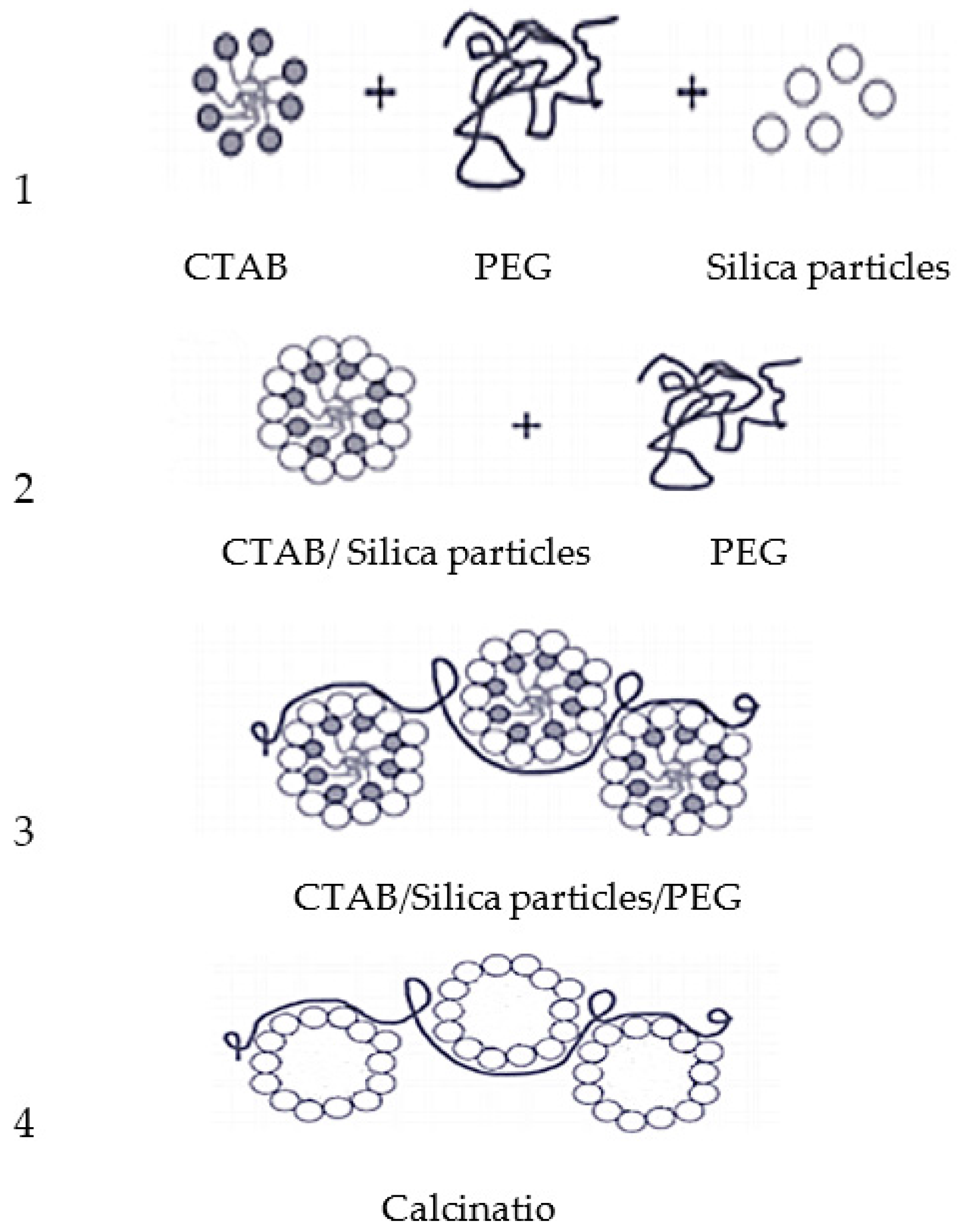
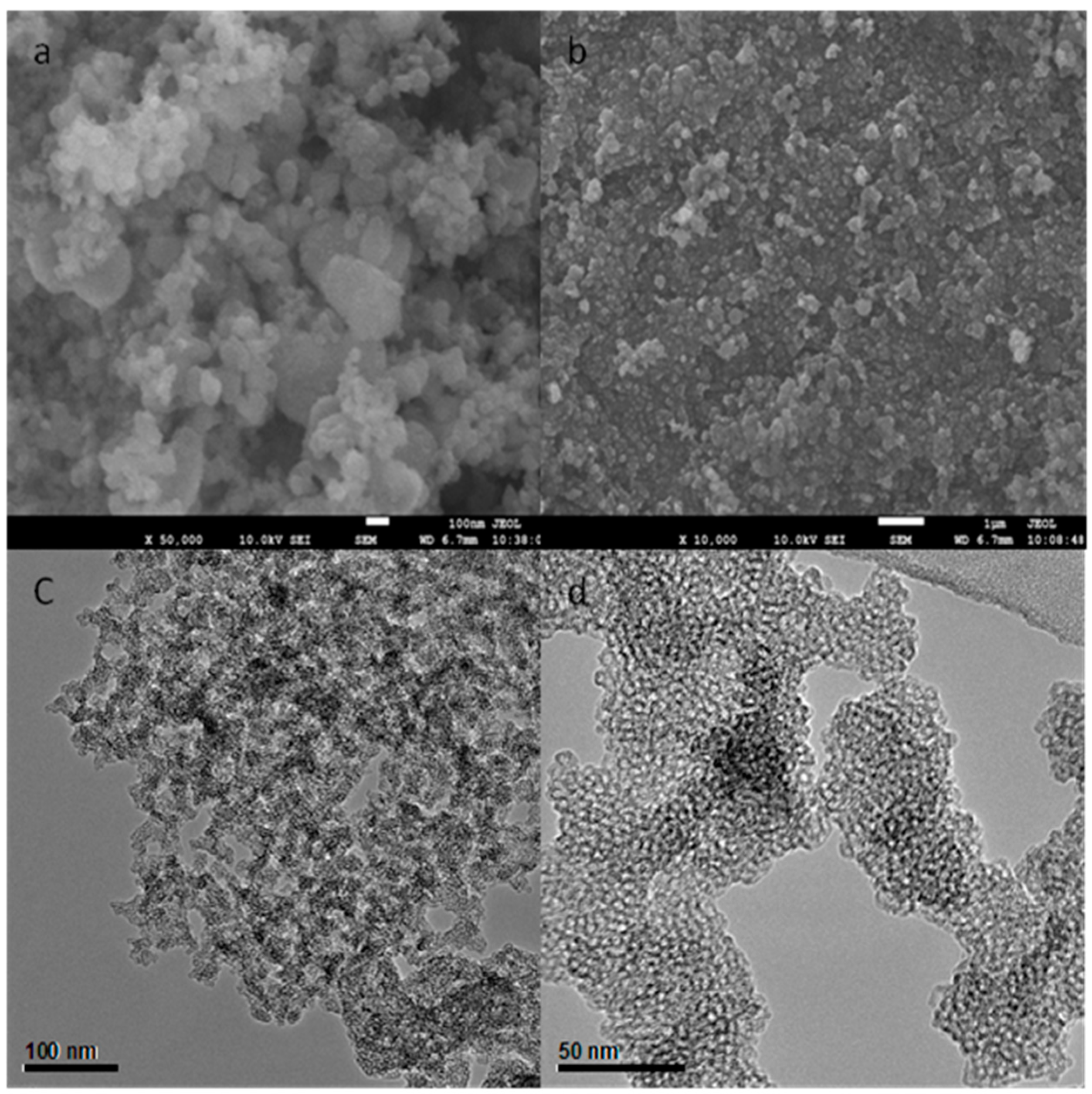

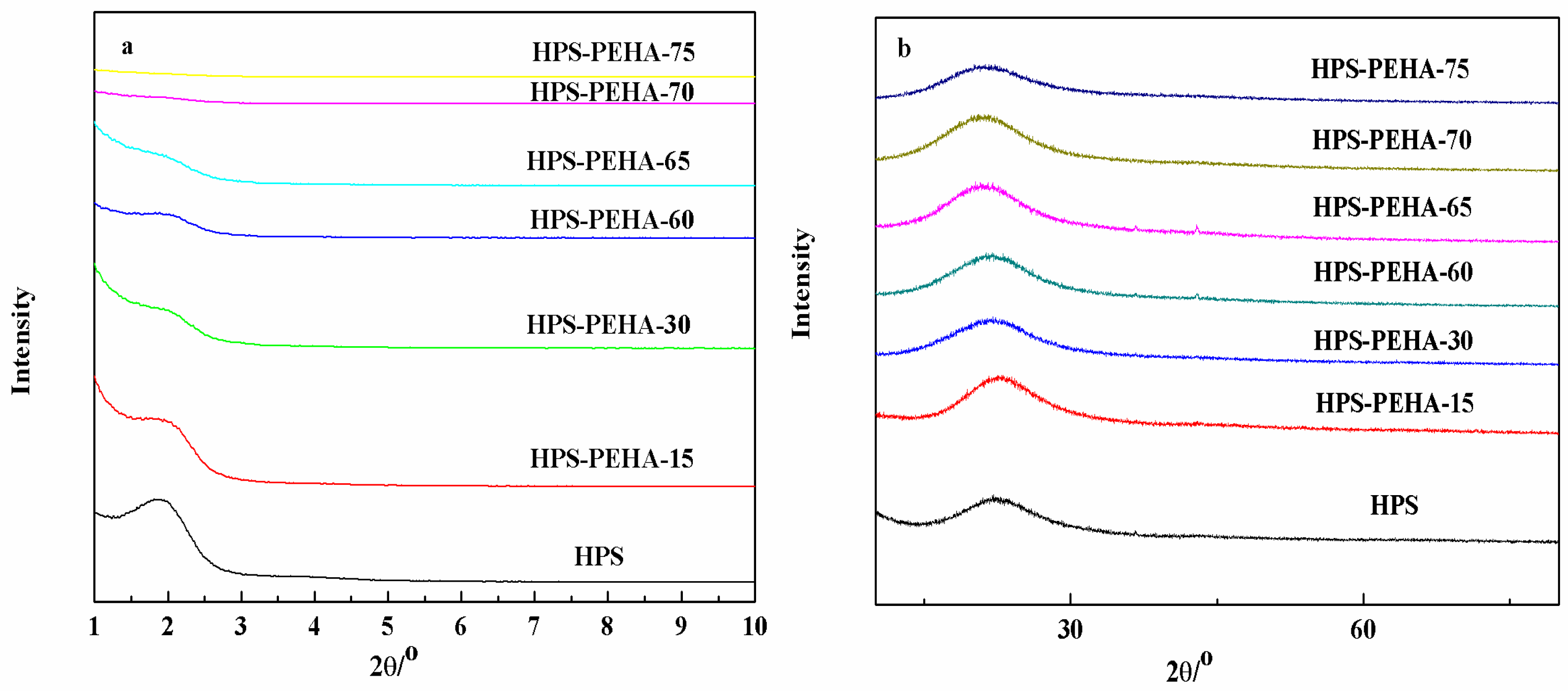
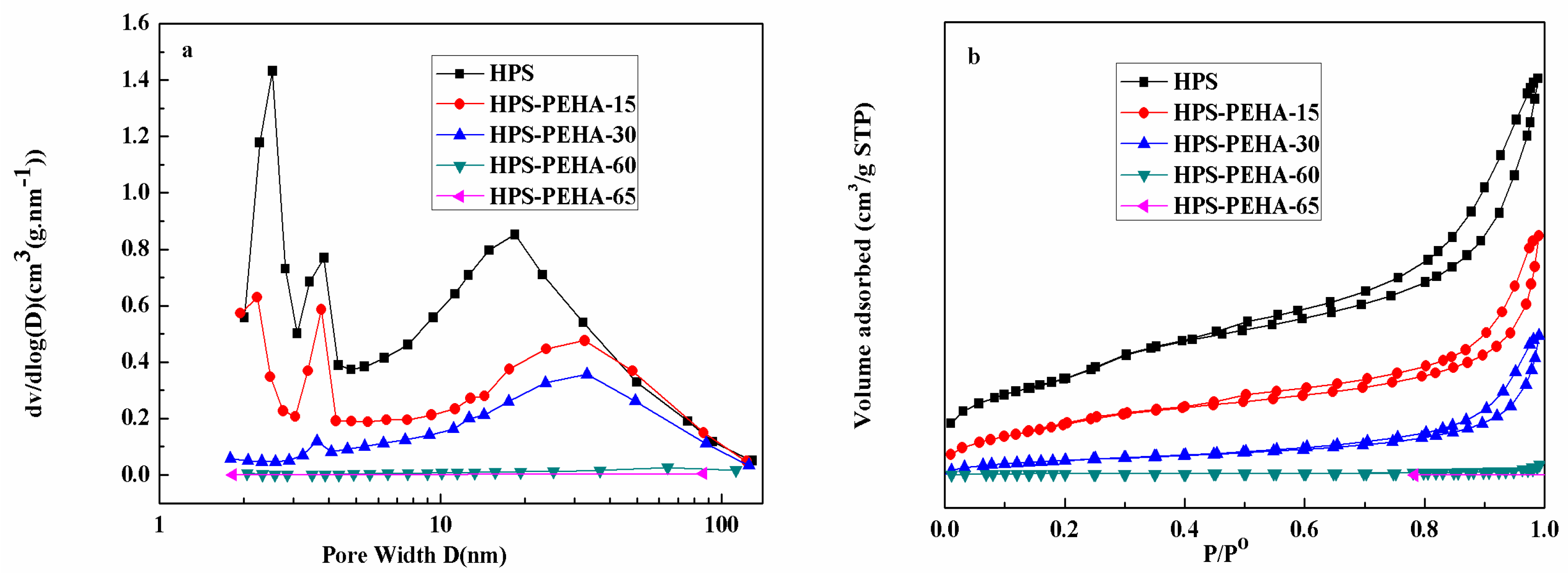
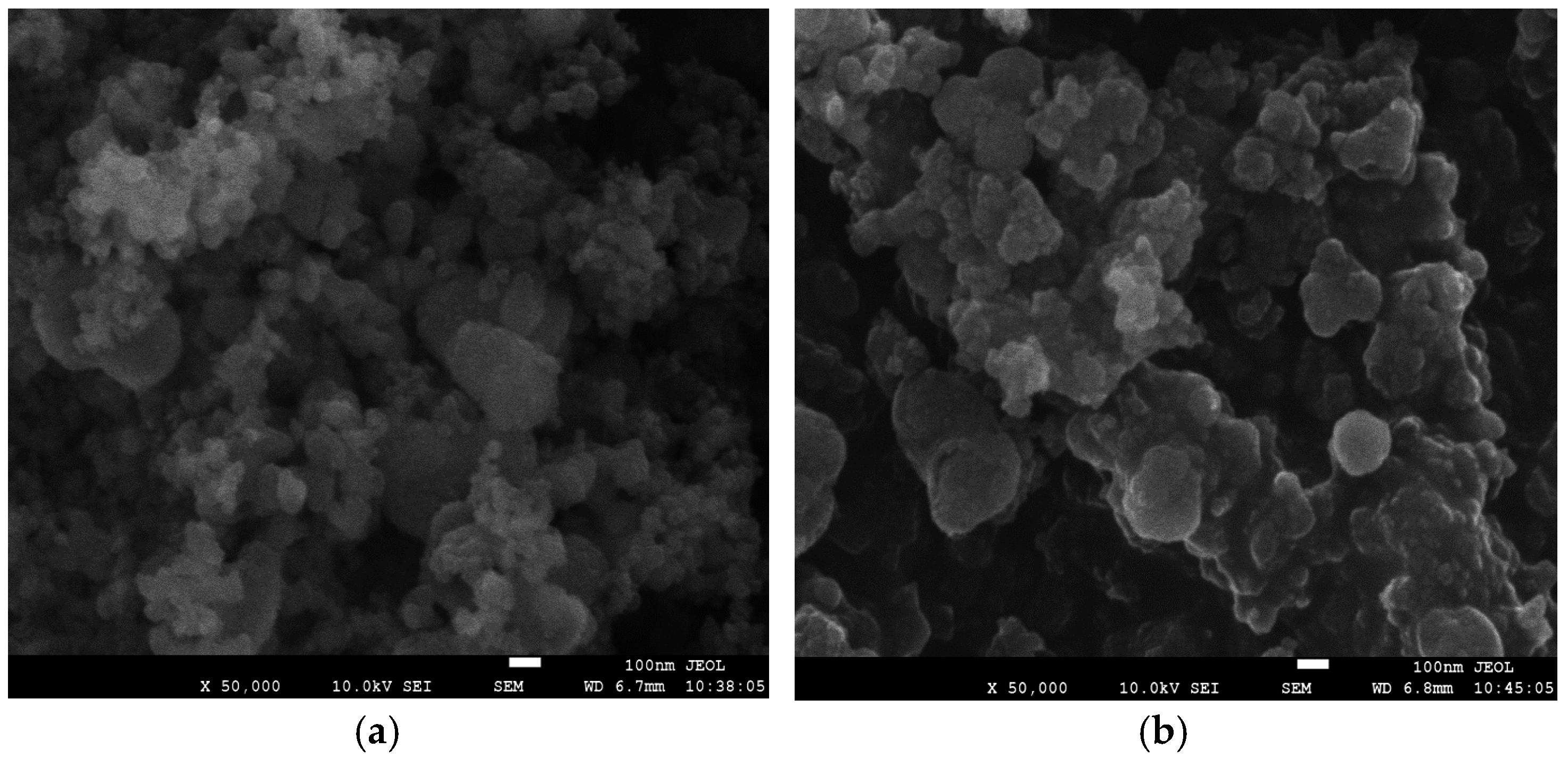

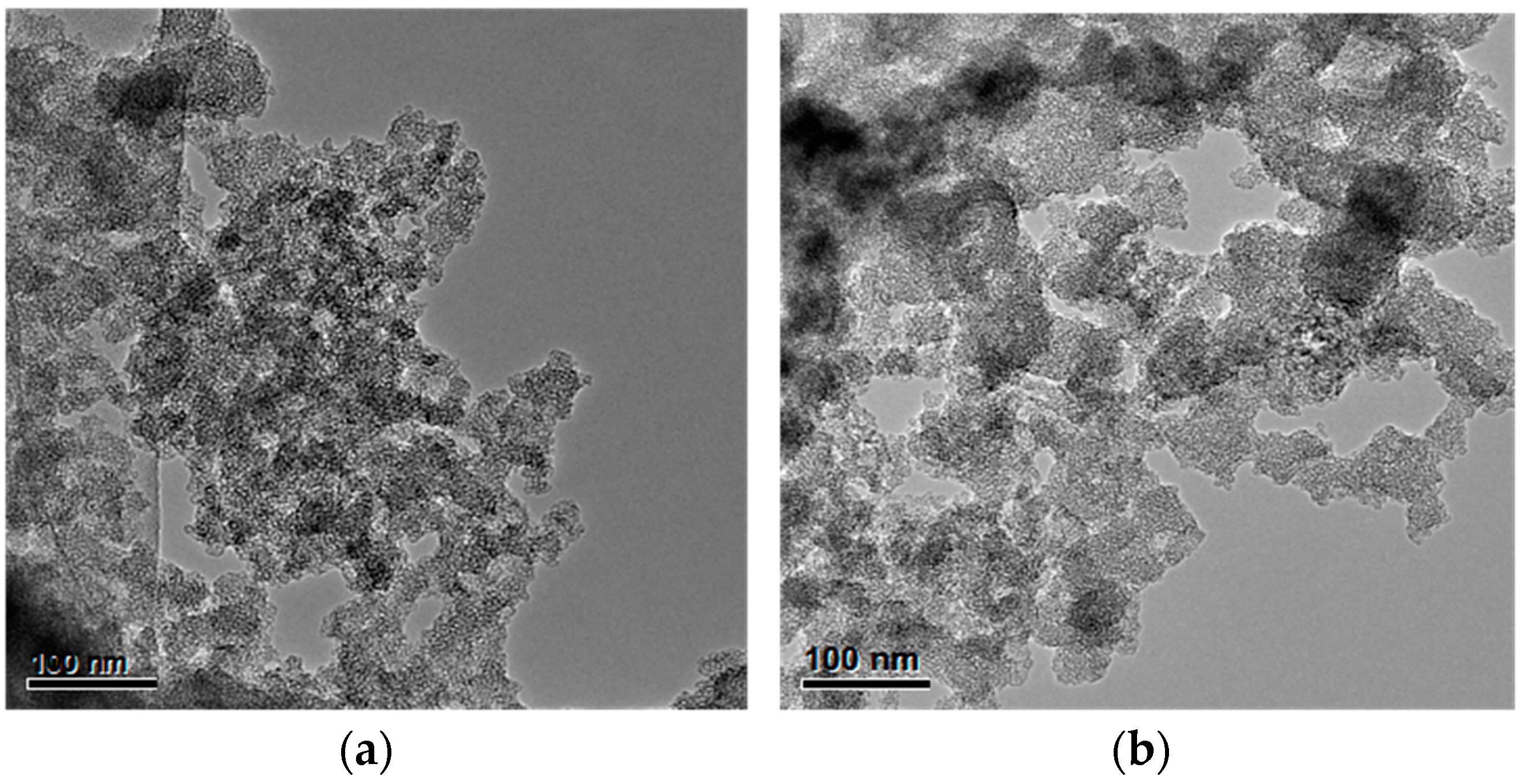
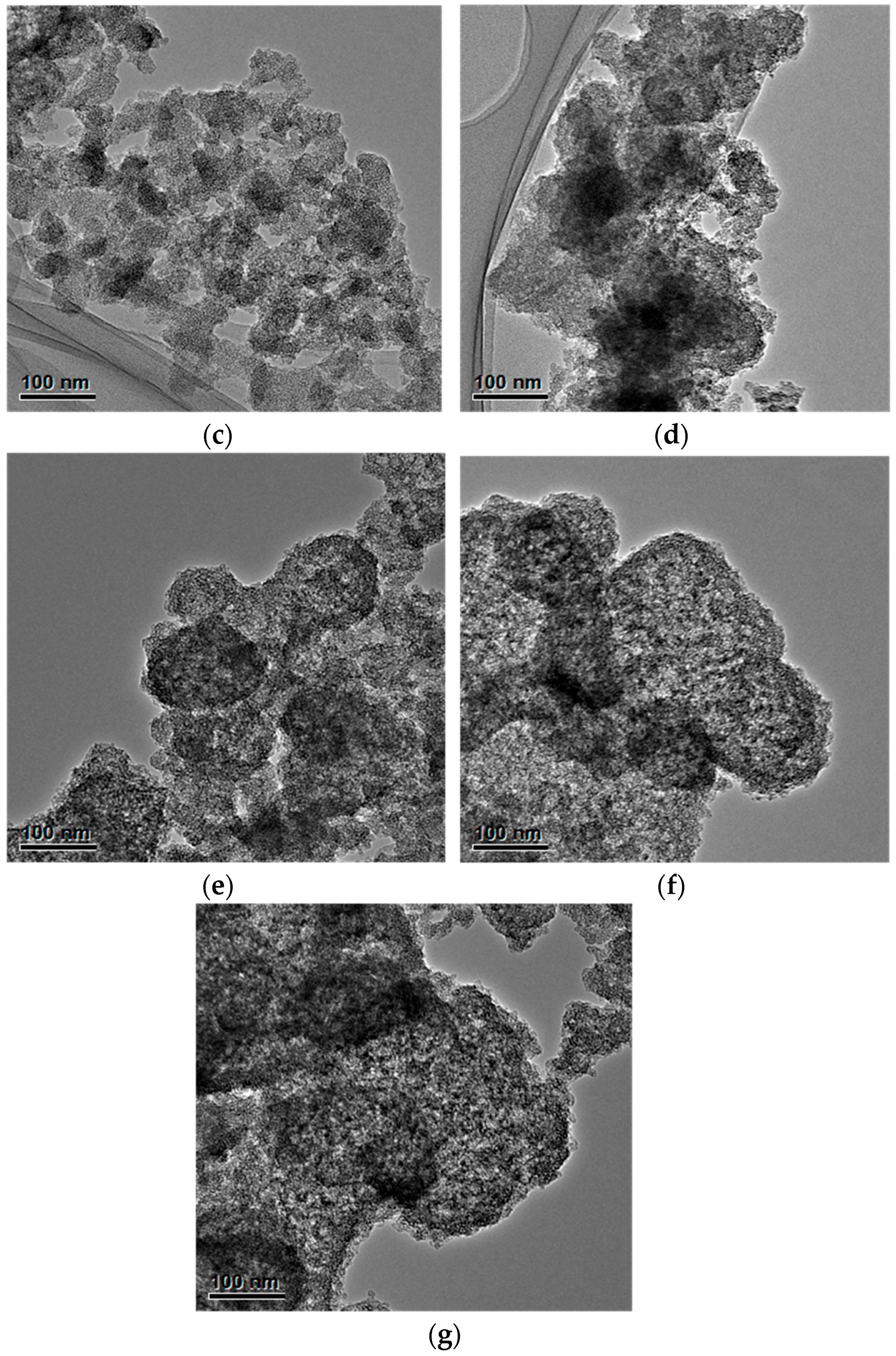
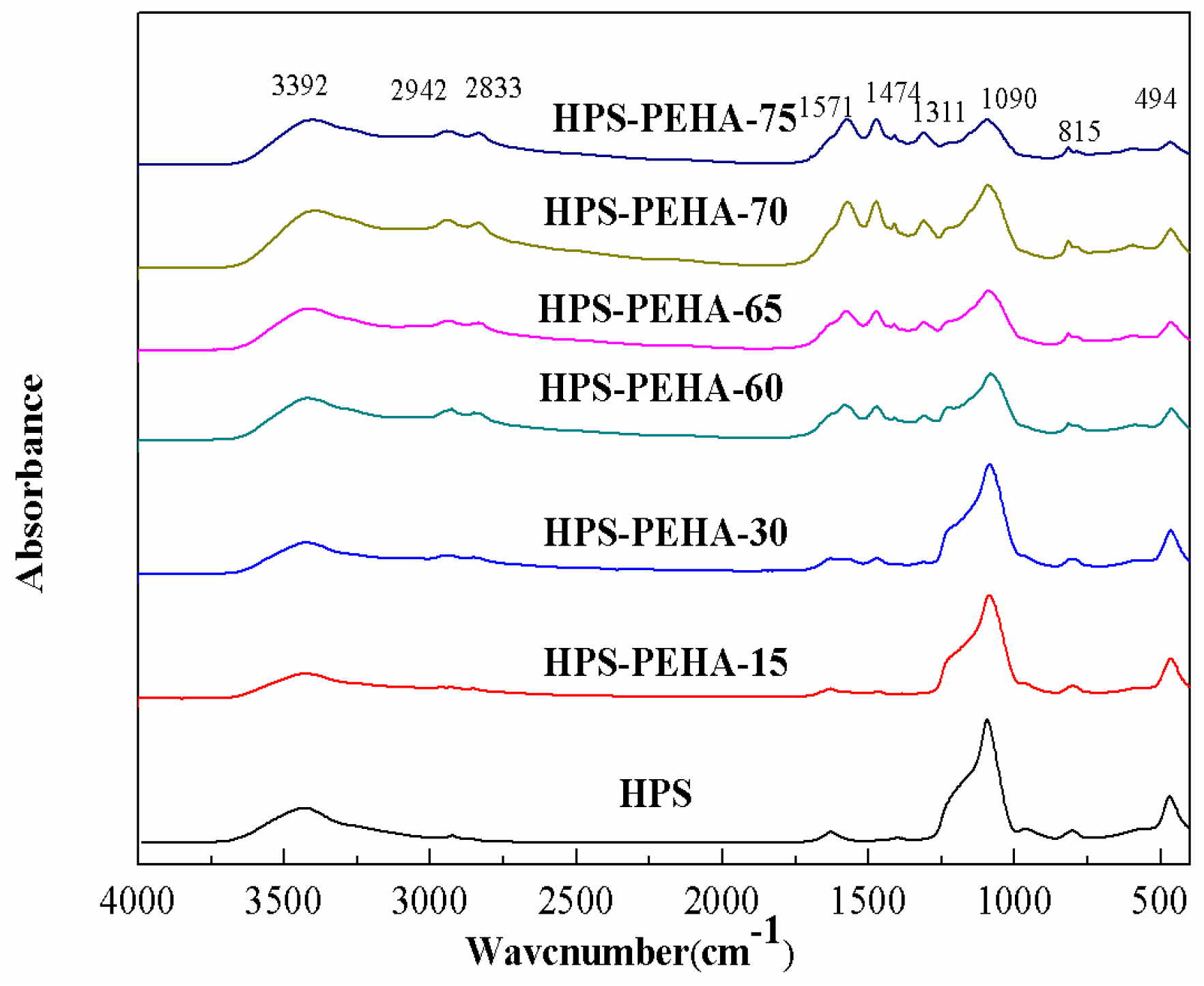

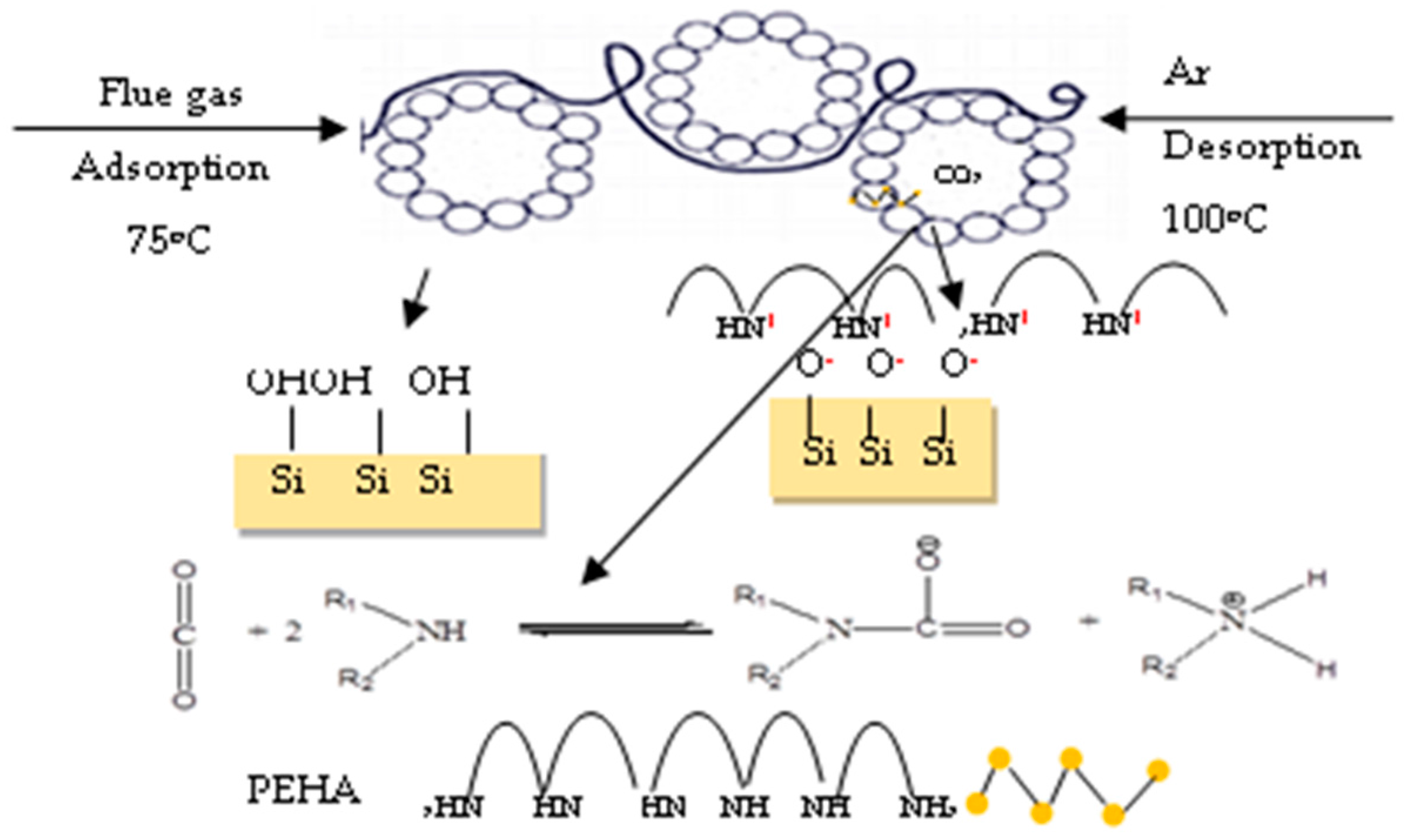
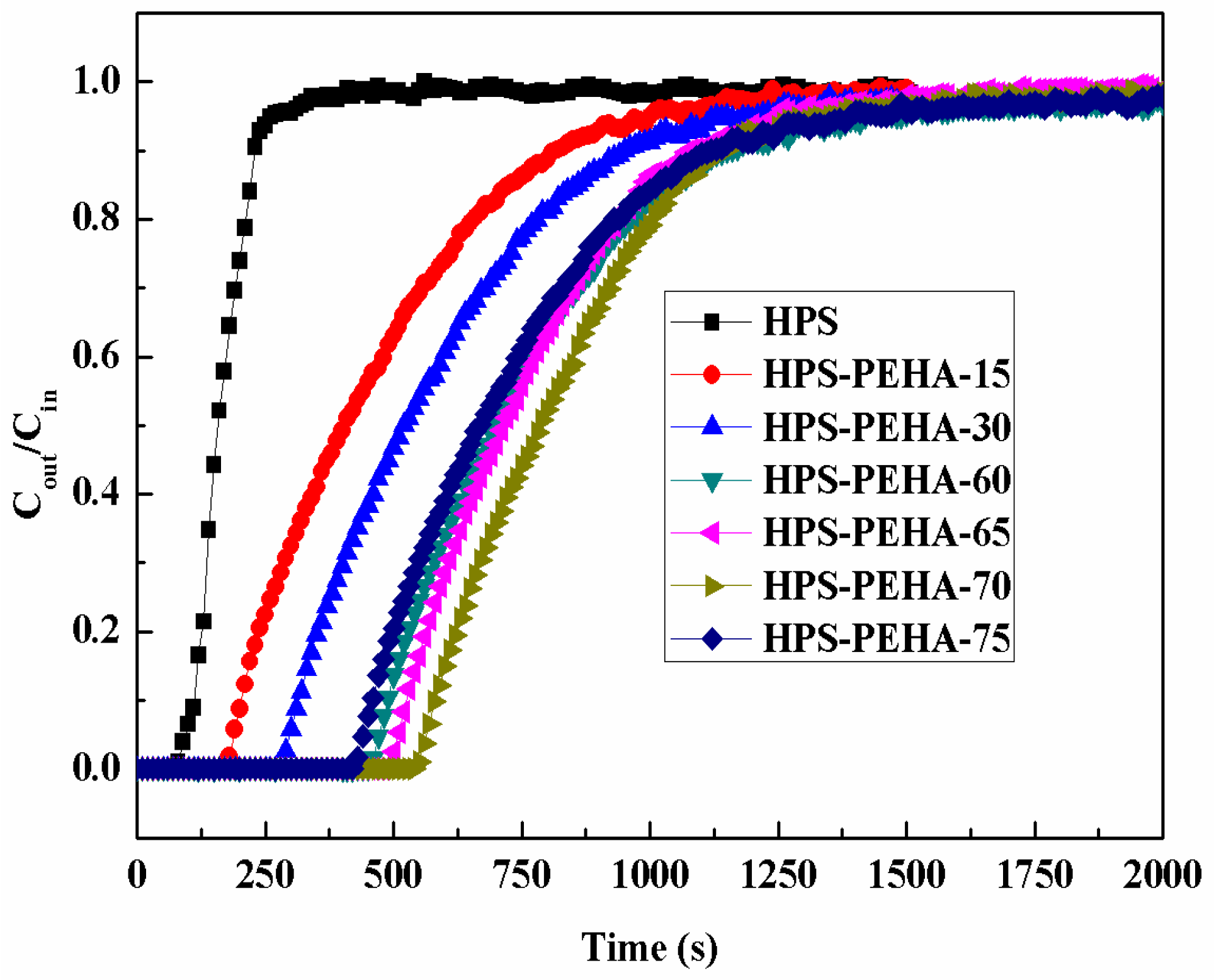
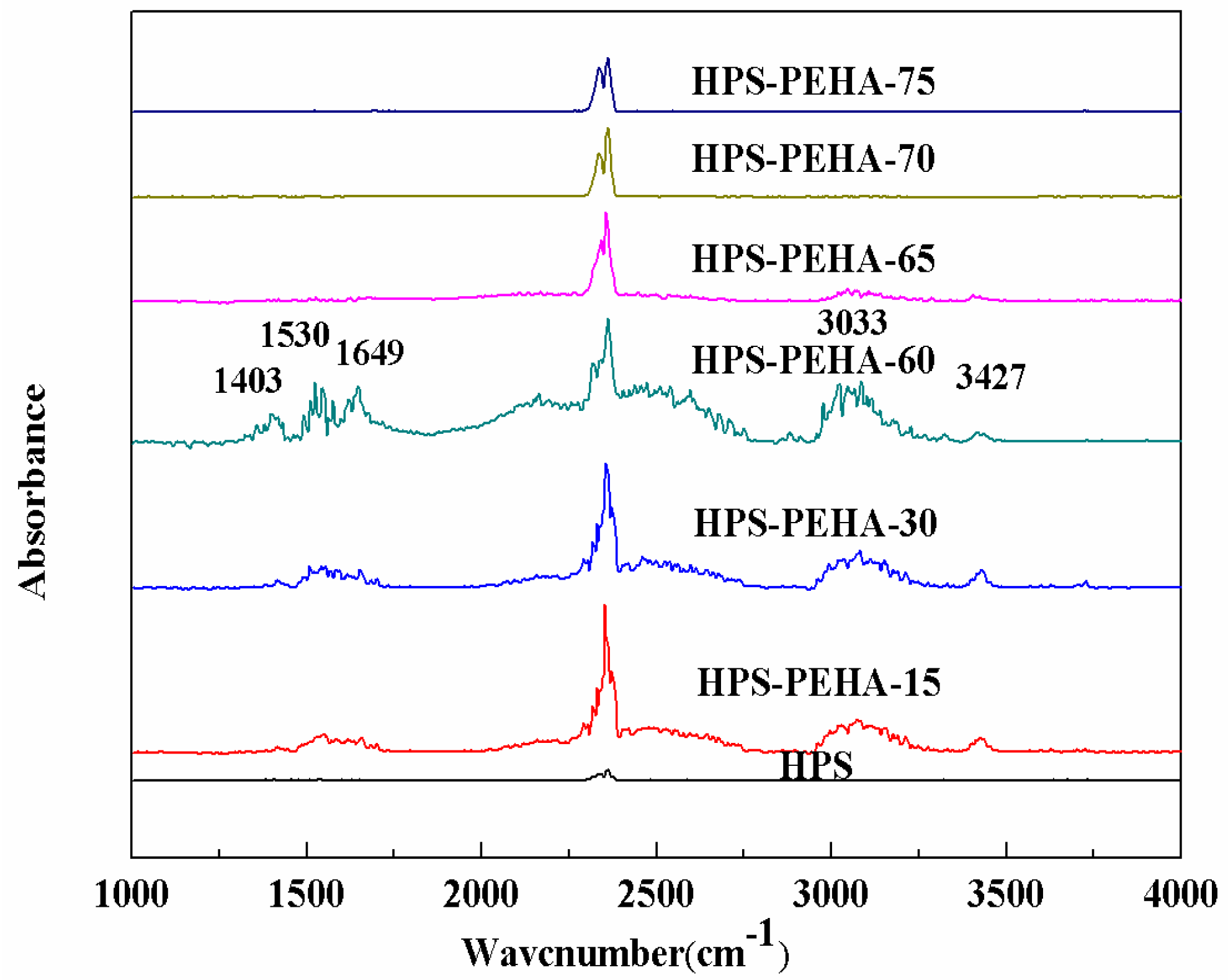
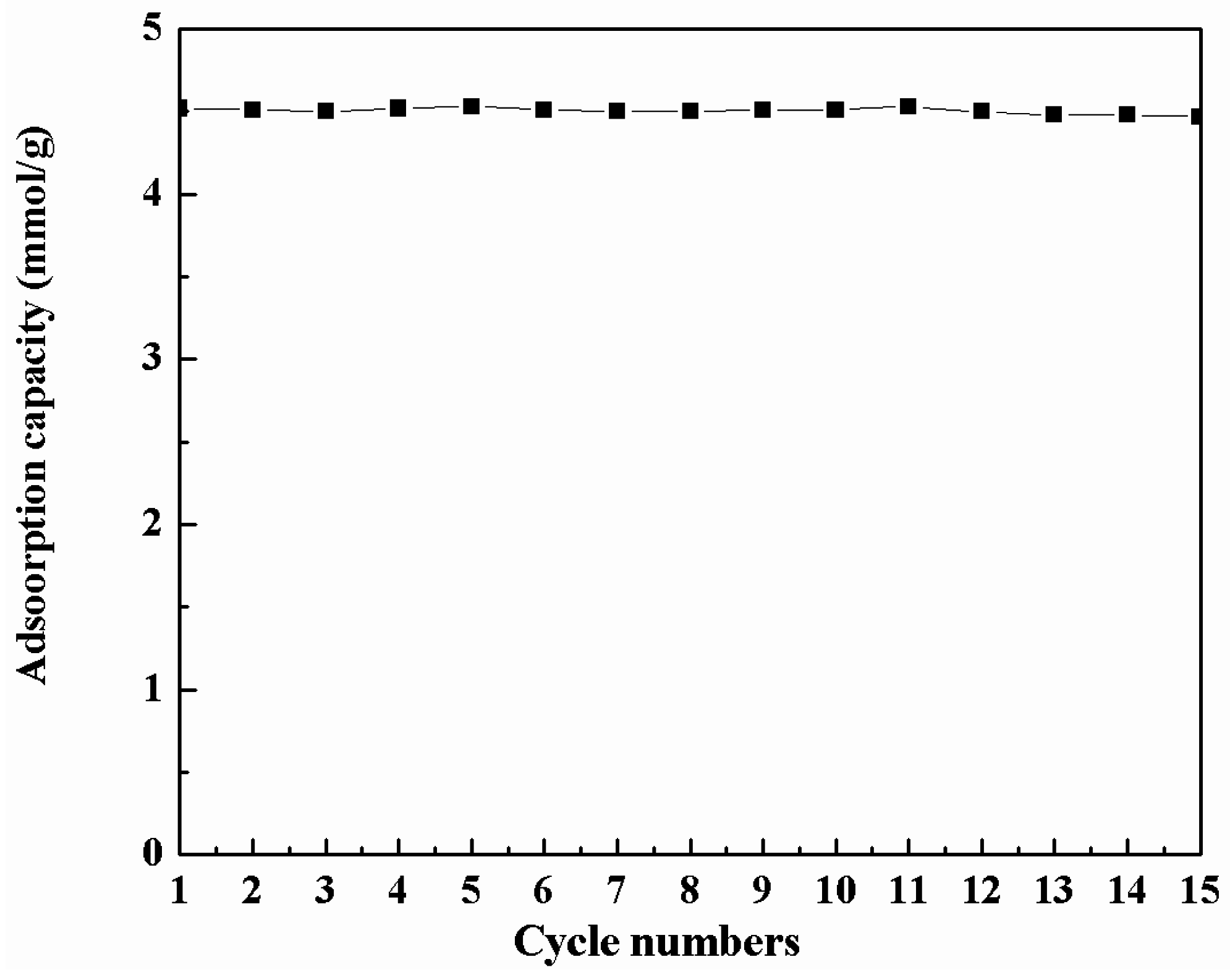
| Samples | SBET (m2/g) | VBJH (cm3/g) | Vmic (cm3/g) | Daverage (nm) |
|---|---|---|---|---|
| HPS | 544 | 1.00 | 0.03 | 6.96 |
| HPS-PEHA-15 | 302 | 0.60 | 0 | 7.59 |
| HPS-PEHA-30 | 89 | 0.34 | 0 | 15.04 |
| HPS-PEHA-60 | 7 | 0.02 | 0 | 23.90 |
| HPS-PEHA-65 | 2 | 0 | 0 | 7.60 |
| HPS-PEHA-70 | 0 | 0 | 0 | 0 |
| HPS-PEHA-75 | 0 | 0 | 0 | 0 |
| Sample | Adsorption Temperature (°C) | N Content (mmol/g) | Adsorption Capacity (mmol/g) | CO2/N | ko (mL/min·g) | kd (min−1) | R2 |
|---|---|---|---|---|---|---|---|
| HPS | 75 | 0 | 0.3 | – | 150.08 | 0.37 | 0.9989 |
| HPS-PEHA-15 | 75 | 3.68 | 1.4 | 0.38 | 752.21 | 0.40 | 0.9987 |
| HPS-PEHA-30 | 75 | 6.67 | 2.4 | 0.36 | 1042.95 | 0.45 | 0.9977 |
| HPS-PEHA-60 | 75 | 10.80 | 3.8 | 0.35 | 1107.87 | 0.47 | 0.9989 |
| HPS-PEHA-65 | 75 | 12.06 | 4.2 | 0.35 | 1175.99 | 0.47 | 0.9988 |
| HPS-PEHA-70 | 75 | 13.03 | 4.5 | 0.35 | 1243.28 | 0.49 | 0.9986 |
| HPS-PEHA-75 | 75 | 14.38 | 3.7 | 0.26 | 910.68 | 0.70 | 0.9977 |
| Sample | Adsorption Temperature (°C) | N Content (mmol/g) | Adsorption Capacity (mmol/g) | CO2/N | ko (mL/min·g) | kd (min−1) | R2 |
|---|---|---|---|---|---|---|---|
| HPS-PEHA-70 | 30 | 13.03 | 3.2 | 0.26 | 806.35. | 0.19 | 0.9997 |
| 50 | 13.03 | 3.7 | 0.28 | 951.43 | 0.31 | 0.9995 | |
| 70 | 13.03 | 4.3 | 0.33 | 1292.67 | 0.45 | 0.9995 | |
| 75 | 13.03 | 4.5 | 0.35 | 1343.28 | 0.49 | 0.9994 | |
| 90 | 13.03 | 3.5 | 0.27 | 1798.18 | 0.99 | 0.9991 |
© 2016 by the authors; licensee MDPI, Basel, Switzerland. This article is an open access article distributed under the terms and conditions of the Creative Commons Attribution (CC-BY) license (http://creativecommons.org/licenses/by/4.0/).
Share and Cite
Ji, C.; Huang, X.; Li, L.; Xiao, F.; Zhao, N.; Wei, W. Pentaethylenehexamine-Loaded Hierarchically Porous Silica for CO2 Adsorption. Materials 2016, 9, 835. https://doi.org/10.3390/ma9100835
Ji C, Huang X, Li L, Xiao F, Zhao N, Wei W. Pentaethylenehexamine-Loaded Hierarchically Porous Silica for CO2 Adsorption. Materials. 2016; 9(10):835. https://doi.org/10.3390/ma9100835
Chicago/Turabian StyleJi, Changchun, Xin Huang, Lei Li, Fukui Xiao, Ning Zhao, and Wei Wei. 2016. "Pentaethylenehexamine-Loaded Hierarchically Porous Silica for CO2 Adsorption" Materials 9, no. 10: 835. https://doi.org/10.3390/ma9100835





